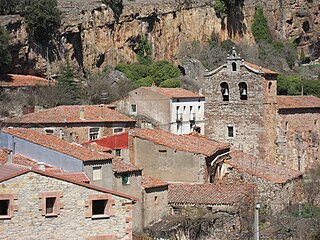La Serranía
You can help expand this article with text translated from the corresponding article in Spanish. (October 2012) Click [show] for important translation instructions.
|

La Serranía is a comarca in the province of Guadalajara, central Spain, with the capital in the city of Sigüenza. It is one of the less populated regions in Europe. La Serranía is home to monumental villages such as Anguita, Atienza, Luzón, Palazuelos.
History

Abundant archaeological sites from the Iron Age have been found, especially around Sigüenza. There are deposits in Santamera, Riosalido and Castilviejo de Guijosa.
During the Romanization of Hispania in the second century BC, Sigüenza was one of the last Arevaci bastions to fall. Roman roads still exist in these environs and remains of mansions, cauponas, taverns and mutationes have been found in places like Mandayona, Palazuelos, Carabias and Alcuneza.
There are few Visigoths remains, as in the rest of the Iberian Peninsula, although regalia have been found in a cemetery in Palazuelos.

Castles in Alcorlo, Atienza, Beleña de Sorbe, Cogolludo, Riba de Santiuste and Sigüenza, as well as the Bujarrabal and Barbatona towers date back to the Andalusi period.
From the twelfth century onward, after the Castilian conquest, rural Romanesque style was developed throughout the region, abundant examples of which survive to date, though significantly transformed in the seventeenth century.
Atienza increased to fifteen churches, of which five of Romanesque origin remain today. Other examples of Romanesque present in the Pela highlands are the San Bartolome de Campisábalos church, the San Pedro de Villacadima church and the Santa Coloma de Albendiego hermitage, with its prominent apse.
In Sigüenza there are the San Vicente and Santiago churches. Other noteworthy churches in the rest of the region are the Salvador de Carabias church, the Pinilla de Jadraque Church of the Assumption, the Saúca church of the Assumption and the Beleña de Sorbe church of the Assumption. Also of note is the Bonaval Monastery, in the Jarama valley, near Retiendas, dating originally to 1162 and mixing Romanesque with Gothic.
